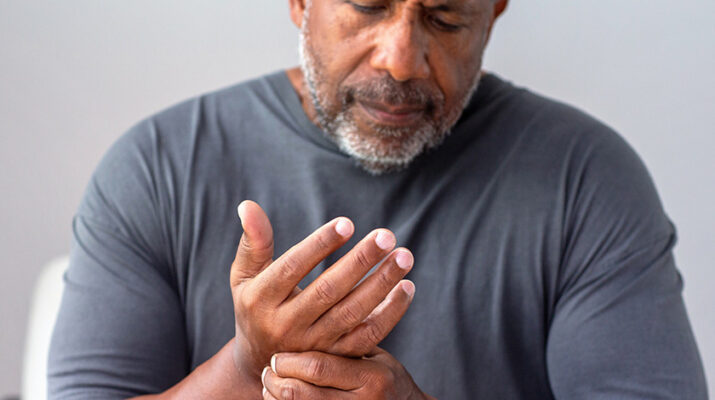By Barbara Pierce

Nearly one person in four in the U.S. has some form of arthritis, according to the Centers for Disease Control and Prevention. It can happen to anyone, but becomes more common as we age.
Board-certified family physician Benjamin Friedell, chief of primary care at Bassett Healthcare Network in Oneonta, answered our questions about this common concern of many.
Arthritis is a broad term that covers more than 100 diseases. Osteoarthritis is by far the most common form of arthritis; it can damage any joint, tissues around the joint and other connective tissues. It occurs most often in hands, hips, spine and knees. We’ll discuss osteoarthritis, the ‘garden variety,’ as Friedell refers to it.
Osteoarthritis involves wear-and-tear damage to a joint’s cartilage — the hard, slick coating on the ends of bones where they form a joint. Cartilage cushions the ends of the bones and allows nearly frictionless joint motion, but enough damage can result in bone grinding directly on bone, which causes pain and restrict movement. This wear and tear can occur over many years or it can be hastened by a joint injury or infection.
1 — How do I know if my pain is arthritis?
You will know it.
If you’ve had joint pain or stiffness that causes you discomfort, has lasted longer than six weeks, or is disrupting what is typical for your body, it’s important to see your primary care provider, as recommended by Friedell at Joint Pain Relief Centers Pain Management.
“The first thing your primary care provider will discern is whether you have arthritis and what type of arthritis,” said Friedell. “They’ll start with an X-ray or other imaging tests to determine whether it’s arthritis and how much arthritis you have.”
This information is necessary to develop a treatment plan. Whatever your condition, it will be easier to stay ahead of your pain if you learn all you can about your condition, including what type of arthritis you have and whether any of your joints are already damaged.
2 — What can I do to relieve my pain?
It’s important to stay active, according to Friedell. Staying active with things that won’t cause you pain to be more precise. For example, if your hip is affected, walking as much as you can would be beneficial. If you can’t walk because it’s too painful, you could try to ride a bike or use a stationary bike instead. Additionally, depending on the condition of the hip, a Total Hip Replacement Procedure could be the way to restore mobility and remove the pain. You can also look into pain management in Dallas, TX.
“Keep active, find an activity you like, and keep doing it,” he continued. “Swimming is great. Even walking in the pool, as the buoyancy of the water supports you, that can be most helpful.”
Do daily, gentle stretches that move your joints through their full range of motion. A physical or occupational therapist can help you develop an exercise program that’s right for you.
When you have arthritis, movement can decrease your pain and stiffness, improve your range of motion, strengthen your muscles, and increase your endurance.
Avoid activities that involve high impact or repetitive motion, like running, high-impact aerobics, tennis.
“It’s important to keep your range of motion,” Friedell added. “For example, your shoulder hurts so you don’t lift it up for several days. Then you go to lift it up and it’s gotten frozen because you didn’t move it. It’s difficult to get your range of motion back. Stay active. Avoid freezing your joints.”
3 — What about medication for pain relief?
The safest medication is Tylenol Arthritis, said Friedell. It’s unique, not related to aspirin, ibuprofen, Motrin, Aleve etc. so it doesn’t cause the problems with your stomach, liver or kidneys like they do.
If Tylenol doesn’t work for you, use over-the-counter ibuprofen or naproxen. As they can cause issues with your stomach, talk with your primary care provider about side effects and what you should watch for, said Friedell.
Some of my patients get relief from the combination of glucosamine and chondroitin, Friedell said. Take it a couple of times a day, not just when your pain is bad. It’s safe and easy.
Topical creams like Bengay, Biofreeze, or others can bring temporary relief.
“I have many geriatric patients and many of them find relief with a lidocaine patch. All of these are over the counter, said Friedell.
Ice or heat packs can relieve pain and inflammation. Some may find relief through products available at places like Body and Mind Cannabis Dispensaries.
4 — What if medication isn’t enough to relieve my pain?
“If none of those medications work, at Bassett we do steroid injections into the painful joint. This keeps the pain away for weeks, months, sometimes even permanently,” Friedell said. If you’re looking for a steroid supplement, check out the Uksteroids homepage..
When nothing else works, surgery, with replacement of the joint is very commonly done.
One caution, Friedell added. There are a lot of unproven therapies offered for arthritis in TV commercials, like copper bracelets. Before you invest any money in these, talk with your primary care physician about them.
5 — What can I do to decrease my risk of getting arthritis?
Age is the primary factor that increases the risk of osteoarthritis, but other causes include previous injury to the joint, obesity, gender and family history. Physical inactivity and smoking also contribute to your risk.

